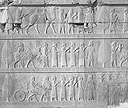Gender
Of course there were men and women in the ancient Middle East, but the meaning of those social identities varied across cultural traditions. In some times and places, women and men had nearly equal legal status, while in other circumstances, women could be carefully controlled (and restricted in their actions) by the men of their family. Gender was never the basis of larger units of social action (like the modern women’s movement) in ancient times.
What’s Missing?
These broad categories are not the only ways in which people of the ancient Middle East identified themselves. There are some suggestions in ancient texts that certain professions were passed from father to son or mother to daughter and that there was some level of identity for scribes, priests, and craftsmen. Another example is the possibility that people in early Mesopotamia, at least, were sometimes identified by city. Finally, tribal groups were given names in texts although they very likely did not differ culturally or linguistically from other named groups in the same area.
If we compare ancient and modern forms of identity, what is largely missing from ancient identity is politics and religion. With a few important exceptions, there was little sense of political identity—subjects of a ruler, or inhabitants of a kingdom, did not develop a common identity as anything like “citizens” of modern states. And, as noted above, religious practice did not begin to define group identity until the rise of monotheistic religions.

 Geoff Emberling
Geoff Emberling
Former Chief Curator, Oriental Institute Museum of the University of Chicago
Guiding Questions
1. What kinds of things relate to or contribute to a person’s sense of identity? How is an understanding of identities crucial to the study of history?
2. What were some of the various ways that people in the ancient Middle East identified themselves?
3. Why is our tendency today to use religious affiliation as a main part of one’s identity a misleading approach when looking at the ancient Middle East?


 Print Page
Print Page


